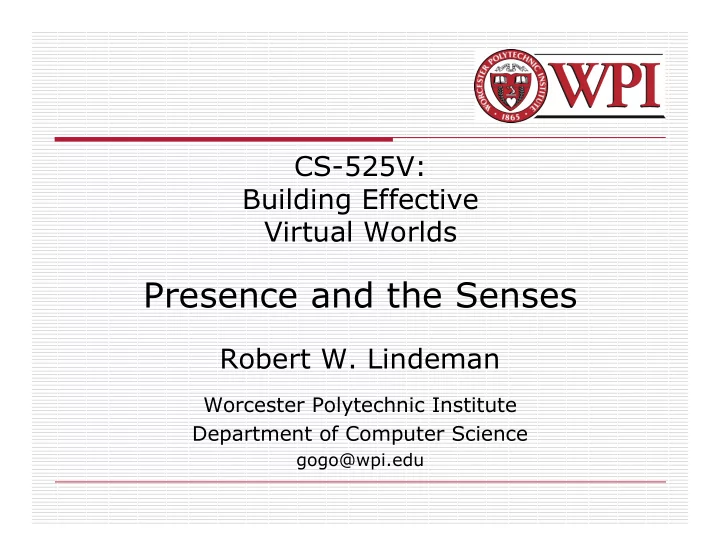

CS-525V: Building Effective Virtual Worlds Presence and the Senses Robert W. Lindeman Worcester Polytechnic Institute Department of Computer Science gogo@wpi.edu
Plan for Tonight More definitions Key issues for effective VR VR as a medium Field trip to HIVE Project ideas R.W. Lindeman - WPI Dept. of Computer Science 2
Some Definitions/Thoughts From the book: 1. An imaginary space often manifested through a medium. 2. A description of a collection of objects in a space and the rules and relationships governing those objects. My definition of VR "Fooling the senses into believing they are experiencing something they are not actually experiencing." [Lindeman, 1999] R.W. Lindeman - WPI Dept. of Computer Science 3
Anatomy of a VR System Virtual reality systems consist of Content: The description of the world Graphical/audio/haptic/... rendering Tracking of people and objects Collision detection Interaction techniques Optional, but common: Networking Autonomous agents R.W. Lindeman - WPI Dept. of Computer Science 4
Some Keys to Success High fidelity (or realism) Graphics, audio, haptics, behaviors, etc. Low latency Tracking Collision detection Rendering Networking Ease of use Low cumber for users Easy integration for programmers Compelling Content R.W. Lindeman - WPI Dept. of Computer Science 5
Key Elements The Virtual World itself Immersive nature of the experience Sensory feedback provided Interactivity supported R.W. Lindeman - WPI Dept. of Computer Science 6
The Virtual World Where does the "Virtual World" exist? R.W. Lindeman - WPI Dept. of Computer Science 7
Immersion and Presence What is immersion ? Physical vs. mental immersion Physical Stuff I wear that feeds my senses Is this objective? Mental How engaged am I? Is this subjective? What is presence ? "Being there" in the environment R.W. Lindeman - WPI Dept. of Computer Science 8
More On Presence Presence is a complex phenomenon Expectation Realism Feeling of non-mediation Can change over time Can change with events Behavioral Physiological R.W. Lindeman - WPI Dept. of Computer Science 9
The Senses All the senses? Which ones? How much is enough? R.W. Lindeman - WPI Dept. of Computer Science 10
The Senses (cont.) See (Visual Sense): Visuals are excellent! Hear (Aural Sense): Spatialized audio is also very good! Smell (Olfactory Sense): Very hard! Too many types of receptors. Touch (Haptic Sense): Application specific and cumbersome Taste (Gustatory Sense): We know the base tastes, but that is it! R.W. Lindeman - WPI Dept. of Computer Science 11
See Head-mounted displays Surround screens Fishtank Domes Stereo/mono Captured graphics Rendered graphics Hybrids, e.g., Augmented Reality R.W. Lindeman - WPI Dept. of Computer Science 12
Hear Headphones Speaker arrays Bone conduction Spatialized sound Rendered sound Sound tracing Synthesized Captured/sampled R.W. Lindeman - WPI Dept. of Computer Science 13
Smell Difficult technologically and physiologically Two main problems Scent generation Scent delivery R.W. Lindeman - WPI Dept. of Computer Science 14
Touch Haptic sense is complex in nature Kinesthetic Proprioception Cutaneous Vibration Pressure Temperature Pain Cumbersome technology R.W. Lindeman - WPI Dept. of Computer Science 15
Taste Relies on getting smell right Try yogurt or jellybeans with your nose plugged Five basic tastes Sweet Sour Bitter Salty Umami (Japanese for "savory") It's why MSG works! Receptors on the tongue specialized for each Without saliva, we don't taste R.W. Lindeman - WPI Dept. of Computer Science 16
Interaction Tight coupling between action and reaction Low latency "Expected" response Virtual nature of content requires using interface tools Combination of virtual and physical attributes We will cover this a lot more later! R.W. Lindeman - WPI Dept. of Computer Science 17
From HCI The "best" system for a VR application will take into account The Target User The Task being performed, and The Physical Environment where the activity will take place. We should too! R.W. Lindeman - WPI Dept. of Computer Science 18
Recommend
More recommend